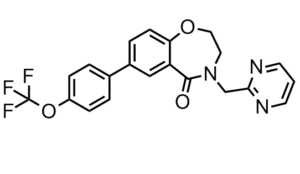This product is for research use only, not for human use. We do not sell to patients.

| Size | Price | Stock |
|---|---|---|
| 5mg | $420 | To Be Confirmed |
| 10mg | $610 | To Be Confirmed |
| 25mg | $1020 | To Be Confirmed |
| 50mg | $1450 | To Be Confirmed |
| 100mg | $2020 | To Be Confirmed |
| 250mg | $3300 | To Be Confirmed |
Cat #: V3407 CAS #: 1443211-72-0; 1448754-43-5 (HCl salt) Purity ≥ 98%
Description: Eleclazine (also known as GS-6615) is a novel late Na+ current inhibitor with IC50 value of 0.7 uM. Enhanced late Na+ current (late INa ) in the myocardium is pro-arrhythmic. Inhibition of this current is a promising strategy to stabilize ventricular repolarization and suppress arrhythmias. Eleclazine was a selective inhibitor of late INa , stabilizes the ventricular repolarization and suppresses arrhythmias in a model of LQT3. The concentrations at which the electrophysiological effects of Eleclazine were observed are comparable to plasma levels associated with QTc shortening in patients with LQT3, indicating that these effects are clinically relevant. Eleclazine is currently in clinical development for the treatment of long QT syndrome 3 (LQT3).
Publications Citing InvivoChem Products
Product Promise

- Physicochemical and Storage Information
- Protocol
- Related Biological Data
- Stock Solution Preparation
- Quality Control Documentation
| Molecular Weight (MW) | 415.37 |
|---|---|
| Molecular Formula | C21H16F3N3O3 |
| CAS No. | 1443211-72-0; 1448754-43-5 (HCl salt) |
| Storage | -20℃ for 3 years in powder form |
| -80℃ for 2 years in solvent | |
| Solubility In Vitro | DMSO: 10 mM |
| Water: <1 mg/mL | |
| Ethanol: | |
| SMILES Code | O=C1N(CC2=NC=CC=N2)CCOC3=CC=C(C4=CC=C(OC(F)(F)F)C=C4)C=C13 |
| Synonyms | GS-6615; GS 6615; GS6615; Eleclazine |
| Protocol | In Vitro | In vitro activity: Eleclazine hydrochloride (also known as GS-6615) is a novel late Na+ current inhibitor with IC50 value of 0.7 uM. Enhanced late Na+ current (late INa ) in the myocardium is pro-arrhythmic. Inhibition of this current is a promising strategy to stabilize ventricular repolarization and suppress arrhythmias. Eleclazine was a selective inhibitor of late INa , stabilizes the ventricular repolarization and suppresses arrhythmias in a model of LQT3. The concentrations at which the electrophysiological effects of Eleclazine were observed are comparable to plasma levels associated with QTc shortening in patients with LQT3, indicating that these effects are clinically relevant. Kinase Assay: Eleclazine is currently in clinical development for the treatment of long QT syndrome 3 (LQT3). Eleclazine hydrochloride inhibits ATX-II enhanced late INa in ventricular myocytes, shorten the ATX-II induced prolongation of APD, MAPD, QT interval, and decreased spatiotemporal dispersion of repolarization and ventricular arrhythmias. Inhibition by GS-6615 of ATX-II enhanced late INa is strongly correlated with shortening of myocyte APD and isolated heart MAPD Cell Assay: GS-6615 inhibited ATX-II enhanced late INa in ventricular myocytes (IC50 = 0.7 μM), shortened the ATX-II induced prolongation of APD, MAPD, QT interval, and decreased spatiotemporal dispersion of repolarization and ventricular arrhythmias. Inhibition by GS-6615 of ATX-II enhanced late INa was strongly correlated with shortening of myocyte APD and isolated heart MAPD (R2 = 0.94 and 0.98 respectively). In contrast to flecainide, GS-6615 had the minimal effects on peak INa . GS-6615 did not decrease the maximal upstroke velocity of the action potential (Vmax) nor widen QRS intervals. |
|---|
| Solvent volume to be added | Mass (the weight of a compound) | |||
|---|---|---|---|---|
| Mother liquor concentration | 1mg | 5mg | 10mg | 20mg |
| 1mM | 2.4075 mL | 12.0375 mL | 24.0749 mL | 48.1498 mL |
| 5mM | 0.4815 mL | 2.4075 mL | 4.8150 mL | 9.6300 mL |
| 10mM | 0.2407 mL | 1.2037 mL | 2.4075 mL | 4.8150 mL |
| 20mM | 0.1204 mL | 0.6019 mL | 1.2037 mL | 2.4075 mL |
This equation is commonly abbreviated as: C1 V1 = C2 V2
- (1) Please be sure that the solution is clear before the addition of next solvent. Dissolution methods like vortex, ultrasound or warming and heat may be used to aid dissolving.
- (2) Be sure to add the solvent(s) in order.




































